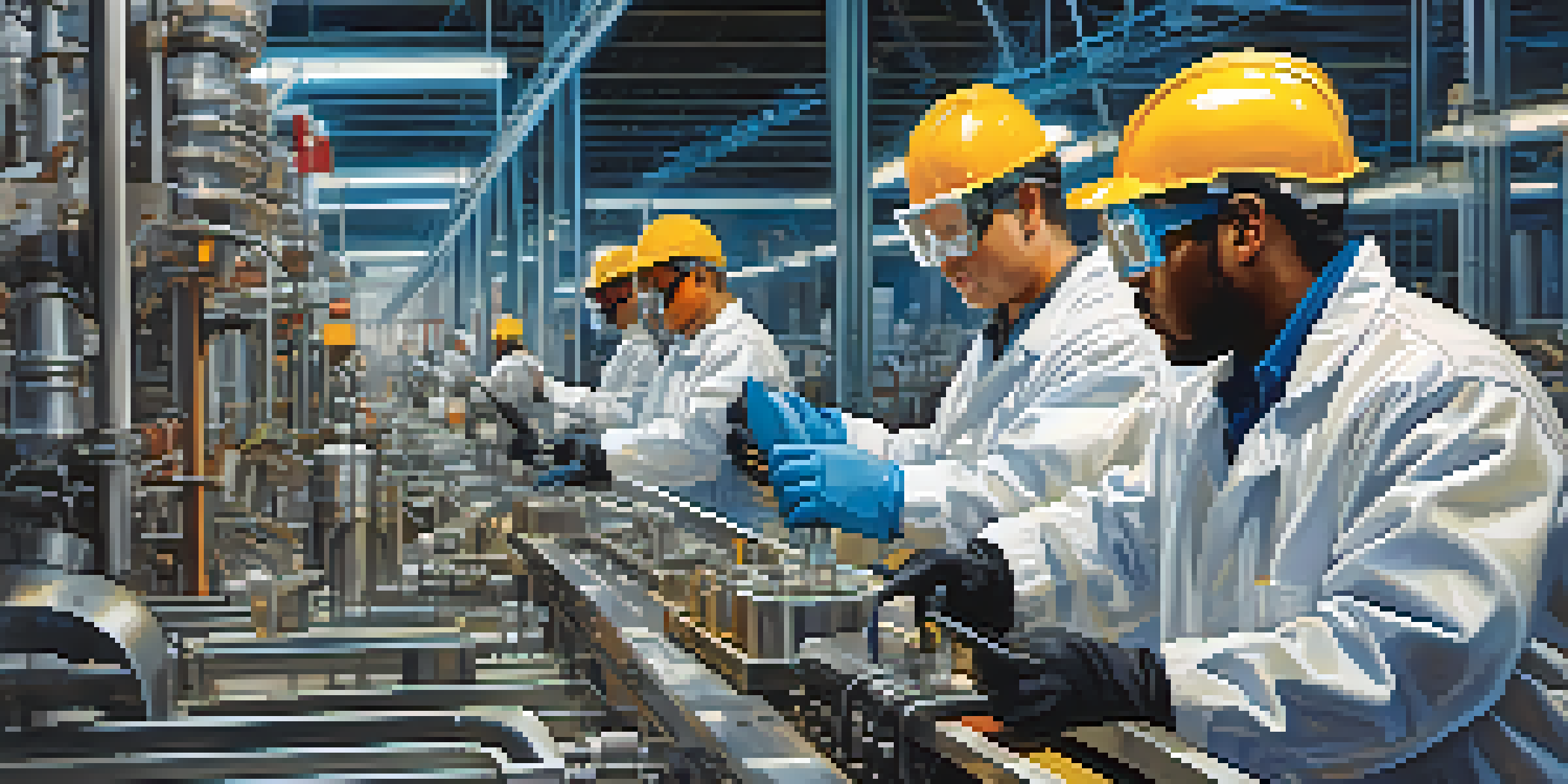Understanding the Risks of Chemical Exposure at Work

What is Chemical Exposure and Why Does It Matter?
Chemical exposure occurs when workers come into contact with hazardous substances, which can happen in various industries, from manufacturing to healthcare. Understanding what chemical exposure is can help employees recognize potential dangers in their work environment. It's crucial because many chemicals can lead to serious health issues, both short-term and long-term.
Safety isn't just a slogan, it's a way of life.
For instance, solvents used in paint thinners can cause headaches or dizziness if inhaled. On a more severe level, repeated exposure to certain chemicals may result in chronic conditions like respiratory diseases or even cancer. This highlights the importance of knowing the risks associated with the chemicals you might encounter at work.
Ultimately, awareness of chemical exposure is the first step towards a safer workplace. By recognizing what chemicals are present and understanding their potential effects, workers can take proactive measures to protect themselves and their colleagues.
Types of Chemical Hazards in the Workplace
Chemical hazards can be classified into several categories, including flammable, corrosive, and toxic substances. Flammable chemicals can ignite easily and pose fire risks, while corrosive chemicals can damage skin or equipment upon contact. Toxic chemicals, on the other hand, can cause severe health effects, including poisoning.

For example, a construction site may have exposure to solvents and adhesives that are flammable and toxic. Identifying these hazards is crucial for implementing proper safety measures. Workers who are aware of the specific types of chemicals they handle are better equipped to manage potential risks.
Understanding Chemical Exposure Risks
Recognizing the potential dangers of chemical exposure is crucial for employee safety and health.
Additionally, understanding the different categories of chemical hazards can lead to improved training and safety protocols. This helps foster a culture of safety within the workplace, where employees feel empowered to report issues and seek assistance when needed.
Health Risks Associated with Chemical Exposure
Chemical exposure can lead to a range of health risks, varying from mild irritations to life-threatening conditions. Short-term exposure might result in symptoms like skin rashes, eye irritation, or respiratory problems. Long-term exposure can lead to chronic health issues such as liver damage, kidney failure, or cancer.
An ounce of prevention is worth a pound of cure.
For instance, workers in certain industries may face risks from asbestos exposure, which is linked to lung cancer and other serious respiratory diseases. These health risks emphasize the importance of monitoring chemical exposure levels in the workplace. Regular health assessments can help identify any early signs of adverse effects.
Moreover, understanding these health risks can motivate both employees and employers to prioritize safety measures. When workers know the potential consequences of chemical exposure, they are more likely to adhere to safety protocols and report unsafe conditions.
Common Sources of Chemical Exposure at Work
Chemical exposure can arise from various sources, including raw materials, cleaning products, and even office supplies. Industries such as agriculture, manufacturing, and construction are particularly vulnerable due to the nature of their operations. For example, pesticides used in agriculture can be hazardous if not handled properly.
Even in seemingly benign environments, like offices, chemical exposure can occur from items like printer ink or cleaning agents. It's important to recognize that exposure isn't limited to large-scale industrial operations; everyday items can also pose risks. Awareness of these sources can help employees take preventive measures.
Implementing Safety Measures
Utilizing personal protective equipment and proper ventilation can significantly reduce the risk of chemical exposure.
By identifying and managing the sources of chemical exposure, workplaces can implement effective strategies to minimize risks. This can include substituting safer materials, improving ventilation, or using less toxic products to create a safer environment for everyone.
Protective Measures Against Chemical Exposure
To safeguard employees from chemical exposure, workplaces must implement protective measures. This can include using personal protective equipment (PPE) like gloves, masks, and goggles to reduce direct contact with hazardous substances. Training employees on how to properly use this equipment is essential for maximizing its effectiveness.
Additionally, engineering controls such as proper ventilation systems can help reduce airborne chemical concentrations. Regular monitoring of chemical levels in the workplace is also vital to ensure safety standards are met. By maintaining a proactive approach, companies can significantly reduce the risk of exposure.
It's essential for employers to foster a culture of safety where employees feel comfortable discussing hazards and suggesting improvements. When everyone works together to prioritize safety, it creates a healthier and more productive work environment.
Regulations and Standards for Chemical Safety
Governments and organizations have established regulations and standards to protect workers from chemical exposure. In the U.S., the Occupational Safety and Health Administration (OSHA) sets guidelines for permissible exposure limits to various chemicals in the workplace. These regulations are designed to ensure that employers take necessary precautions to protect their employees.
For instance, OSHA's Hazard Communication Standard requires employers to inform workers about the hazardous chemicals they might encounter. This includes labeling, Safety Data Sheets (SDS), and employee training. Compliance with these regulations not only keeps workers safe but also promotes a culture of accountability.
Training for Safety Awareness
Regular training is essential for educating employees about chemical hazards and fostering a culture of safety.
By staying informed about current regulations and best practices, both employers and employees can work together to maintain a safe work environment. Understanding these standards reinforces the importance of safety and encourages everyone to prioritize their well-being.
The Role of Training in Chemical Safety Awareness
Training plays a crucial role in promoting chemical safety awareness in the workplace. Regular training sessions can educate employees about the dangers of chemical exposure, the proper use of PPE, and emergency procedures. This knowledge empowers workers to recognize hazards and act accordingly.
For example, during a training session, employees can learn how to read Safety Data Sheets (SDS) and understand the information provided about chemicals. This understanding can help them make informed decisions when handling substances. Training also fosters a sense of responsibility, encouraging workers to share their knowledge with colleagues.

Moreover, ongoing training ensures that safety practices evolve with new regulations and technologies. By committing to continuous education, companies can create a safer workplace and cultivate a culture of safety that benefits everyone.
Creating a Culture of Safety in the Workplace
Establishing a culture of safety is essential for minimizing chemical exposure risks. This involves encouraging open communication about workplace hazards and fostering an environment where employees feel comfortable reporting unsafe conditions. When safety is prioritized, workers are more likely to engage in proactive behaviors to protect themselves and their colleagues.
Leadership plays a vital role in shaping this culture. When management actively demonstrates a commitment to safety, it sets the tone for the entire organization. Regular safety meetings, training sessions, and recognition of safe practices can reinforce the message that safety is a shared responsibility.
Ultimately, a strong culture of safety not only protects employees but also enhances overall productivity and morale. When workers feel safe, they are more focused and engaged in their tasks, contributing to a healthier and more efficient workplace.